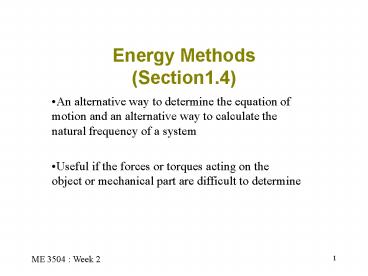Energy Methods Section1'4 PowerPoint PPT Presentation
1 / 37
Title: Energy Methods Section1'4
1
Energy Methods (Section1.4)
- An alternative way to determine the equation of
motion and an alternative way to calculate the
natural frequency of a system - Useful if the forces or torques acting on the
object or mechanical part are difficult to
determine
2
Potential and Kinetic Energy
The potential energy of mechanical systems U is
often stored in springs (remember that for a
spring Fkx)
x0
x0
k
M
Spring
Mass
The kinetic energy of mechanical systems T is due
to the motion of the mass in the system
3
Conservation of Energy
For a simply, conservative (i.e. no damper), mass
spring system the energy must be conserved
At two different times t1 and t2 the increase in
potential energy must be equal to a decrease in
kinetic energy (or visa-versa).
4
Deriving equation of motion
x
x0
k
M
Spring
Mass
5
Natural frequency
If the solution is given by Asin(wtf) then the
maximum potential and kinetic energies can be
used to calculate the natural frequency of the
system
6
Example
q
Compute the natural frequency of this roller
fixed in place by a spring. Assume it is a
conservative system (i.e. no losses) and rolls
with out slipping.
k
m,J
r
x(t)
7
Solution continued
Effective mass
8
Example 1.4.2
q
m
mg
9
Now write down the energy
10
(No Transcript)
11
Example 1.4.4 The effect of including the mass
of the spring on the value of the frequency.
y
y dy
ms, k
m
x(t)
12
- This provides some simple design and modeling
guides
13
What about gravity?
kD
m
k
x(t)
0
mg
D
m
x(t)
14
- Gravity does not effect the equation of motion or
the natural frequency of the system for a linear
system.
15
1.5 More on springs and stiffness
- Longitudinal motion
- A is the cross sectional area (m2)
- E is the elastic modulus (PaN/m2)
- l is the length (m)
- k is the stiffness (N/m)
m
x(t)
16
Figure 1.21 Torsional Stiffness
- Jp is the polar moment of inertia of the rod
- J is the mass moment of inertia of the disk
- G is the shear modulus, l is the length
Jp
0
q(t)
J
17
Example 1.5.1 compute the frequency of a
shaft/mass system J 0.5 kg m2
18
Fig. 1.22 Helical Spring
d diameter of wire 2R diameter of turns n
number of turns x(t) end deflection G shear
modulus of spring material
2R
x(t)
19
Fig 1.23 Transverse beam stiffness
- Strength of materials and experiments yield
f
m
x
20
Samples of Vibrating Systems
- Deflection of continuum (beams, plates, bars,
etc) such as airplane wings, truck chassis, disc
drives, circuit boards - Shaft rotation
- Rolling ships
- See text for more examples.
21
Example 1.5.2 Effect of fuel on frequency of an
airplane wing
- Model wing as transverse beam
- Model fuel as tip mass
- Ignore the mass of the wing and see how the
frequency of the system changes as the fuel is
used up
E, I m
l
x(t)
22
Mass of pod 10 kg empty 1000 kg fullI 5.2x10-5
m4, E 6.9x109 N/m, l 2 m
- Hence the natural frequency changes by an order
of magnitude while it empties out fuel.
23
Combining Springs
- Equivalent Spring
k2
A
k1
B
C
k1
a
b
k2
- This is identical to the combination of
capacitors in electrical circuits
24
Use these to design from available parts
- Discrete springs available in standard values
- Dynamic requirements require specific frequencies
- Mass is often fixed or small amount
- Use spring combinations to adjust wn
- Check static deflection
25
Example 1.5.5 Design of a spring mass system
using available springs series vs parallel
- Let m 10 kg
- Compare a series and parallel combination
- a) k1 1000 N/m, k2 3000 N/m, k3 k4 0
- b) k3 1000 N/m, k4 3000 N/m, k1 k2 0
k2
k1
m
k3
k4
26
Same physical components, very different
frequency Allows some design flexibility in using
off the shelf components
27
Example Find the equivalent stiffness k of the
following system (Fig 1.28, page 41)
k1k2k5
k2
k1
m
m
m
k3
k3
k5
k4
k4
28
Section 1.6 Measurement
- Mass usually pretty easy to measure using a
balance- a static experiment - Stiffness again can be measured statically by
using a simple displacement measurement and
knowing the applied force - Damping can only be measured dynamically
29
Stiffness Measurements
From Static Deflection
Linear Nonlinear
Force or stress
F k x or s? E e
Deflection or strain
From Dynamic Frequency
30
Damping Measurement (Dynamic only)
Define the Logarithmic Decrement
31
Design Considerations (Section 1.7)
- Using the analysis so far to guide the selection
of components.
32
Example 1.7.1
- Mass 2 kg lt m lt 3kg and k gt 200 N/m
- For a possible frequency range of 8.16 rad/s lt
wn lt 10 rad/s - For initial conditions x0 0, v0 lt 300 mm/s
- Choose a c so response is always lt 25 mm
33
Solution
- Write down x(t) for 0 initial displacement
- Look for max amplitude
- Occurs at time of first peak (Tmax)
- Compute the amplitude at Tmax
- Compute z for A(Tmax)0.025
34
(No Transcript)
35
(No Transcript)
36
Example 1.7.3 What happens to a good design when
some one changes the parameters? (Car suspension
system). How does z change with mass?
37
Now add 290 kg of passengers and luggage. What
happens?
So some oscillation results at a lower
frequency.

